B0041VYHGW EBOK (48 page)
Authors: David Bordwell,Kristin Thompson

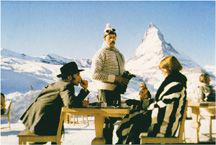
4.43 … and finally to a predominantly white-and-black scheme.
Many of these points about costume apply equally to a closely related area of mise-en-scene, the actors’ makeup. Makeup was originally necessary because actors’ faces would not register well on early film stocks. Up to the present, it has been used in various ways to enhance the appearance of actors on the screen. Over the course of film history, a wide range of possibilities has emerged. Dreyer’s
La Passion de Jeanne d’Arc
was famous for its complete avoidance of makeup
(
4.44
).
This film relied on close-ups and tiny facial changes to create an intense religious drama. On the other hand, Nikolai Cherkasov did not look particularly like Eisenstein’s conception of Czar Ivan IV, so he wore a wig and false beard, nose, and eyebrows for
Ivan the Terrible
(
4.45
).
Changing actors to look like historical personages has been one common function of makeup.

4.44 Light, blank backgrounds focus attention on the actors’ faces in many shots of
La Passion de Jeanne d’Arc.
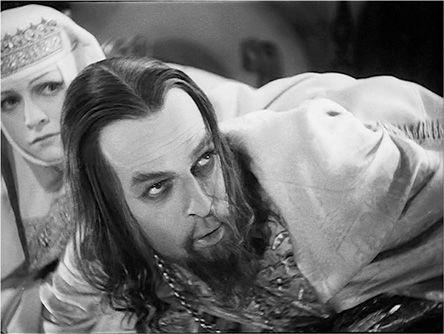
4.45 In
Ivan the Terrible,
Part 1
, makeup shapes the eyebrows and hollows the eye sockets to emphasize Ivan’s piercing gaze.
Today makeup usually tries to pass unnoticed, but it also accentuates expressive qualities of the actor’s face. Since the camera may record cruel details that would pass unnoticed in ordinary life, any unsuitable blemishes, wrinkles, and sagging skin will have to be hidden. The makeup artist can sculpt the face, making it seem narrower or broader by applying blush and shadow. Viewers expect that female performers will wear lipstick and other cosmetics, but the male actors are often wearing makeup, too
(
4.46
,
4.47
).

4.46 In
Heat,
Al Pacino’s makeup gives him slightly rounded eyebrows and, with the help of the lighting, minimizes the bags under his eyes.
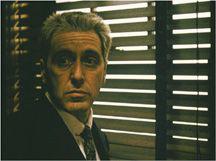
4.47 In
The Godfather
Part III
, made five years before
Heat,
Pacino looks older. Not only has his hair been whitened, but the makeup, again assisted by the lighting, gives him more sunken and baggy eyes, more hollow cheeks, and a longer, flatter chin.
Film actors rely on their eyes to a very great extent (see box,
p. 134
), and makeup artists can often enhance eye behavior. Eyeliner and mascara can draw attention to the eyes and emphasize the direction of a glance. Nearly every actor will also have expressively shaped eyebrows. Lengthened eyebrows can enlarge the face, while shorter brows make it seem more compact. Eyebrows plucked in a slightly rising curve add gaiety to the face, while slightly sloping ones hint at sadness. Thick, straight brows, commonly applied to men, reinforce the impression of a hard, serious gaze. Thus eye makeup can assist the actor’s performance
(
4.48
,
4.49
).

4.48 In
Speed,
Sandra Bullock’s eyeliner, shadow, and arched brows make her eyes vivid and give her an alert expression.
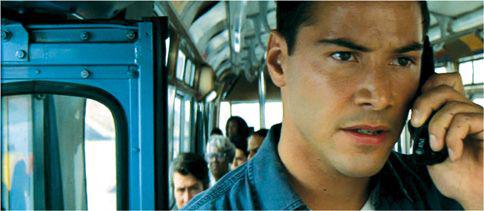
4.49 For the same scene, the eyeliner on Keanu Reeves makes the upper edges of his eyes stand out. Note also the somewhat fierce curve of the eyebrows, accentuating his slight frown.
In recent decades, the craft of makeup has developed in response to the popularity of horror and science fiction genres. Rubber and plasticine compounds create bumps, bulges, extra organs, and layers of artificial skin in such films as David Cronenberg’s
The Fly
(
4.50
).
In such contexts, makeup, like costume, becomes important in creating character traits or motivating plot action.
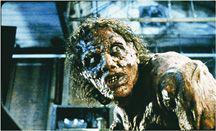
4.50 Jeff Goldblum, nearly unrecognizable under grotesque makeup, during his transformation into
The Fly.
Much of the impact of an image comes from its manipulation of lighting. In cinema, lighting is more than just illumination that permits us to see the action. Lighter and darker areas within the frame help create the overall composition of each shot and thus guide our attention to certain objects and actions. A brightly illuminated patch may draw our eye to a key gesture, while a shadow may conceal a detail or build up suspense about what may be present. Lighting can also articulate textures: the curve of a face, the grain of a piece of wood, the tracery of a spider’s web, the sparkle of a gem.
Lighting shapes objects by creating highlights and shadows. A highlight is a patch of relative brightness on a surface. The man’s face in
4.51
and the edge of the fingers in
4.52
display highlights. Highlights provide important cues to the texture of the surface. If the surface is smooth, like glass or chrome, the highlights tend to gleam or sparkle; a rougher surface, like a coarse stone facing, yields more diffuse highlights.
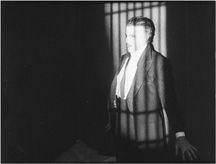
4.51 In
The Cheat,
Cecil B. DeMille suggests a jail cell by casting a bright light on a man’s face and body through unseen bars.
